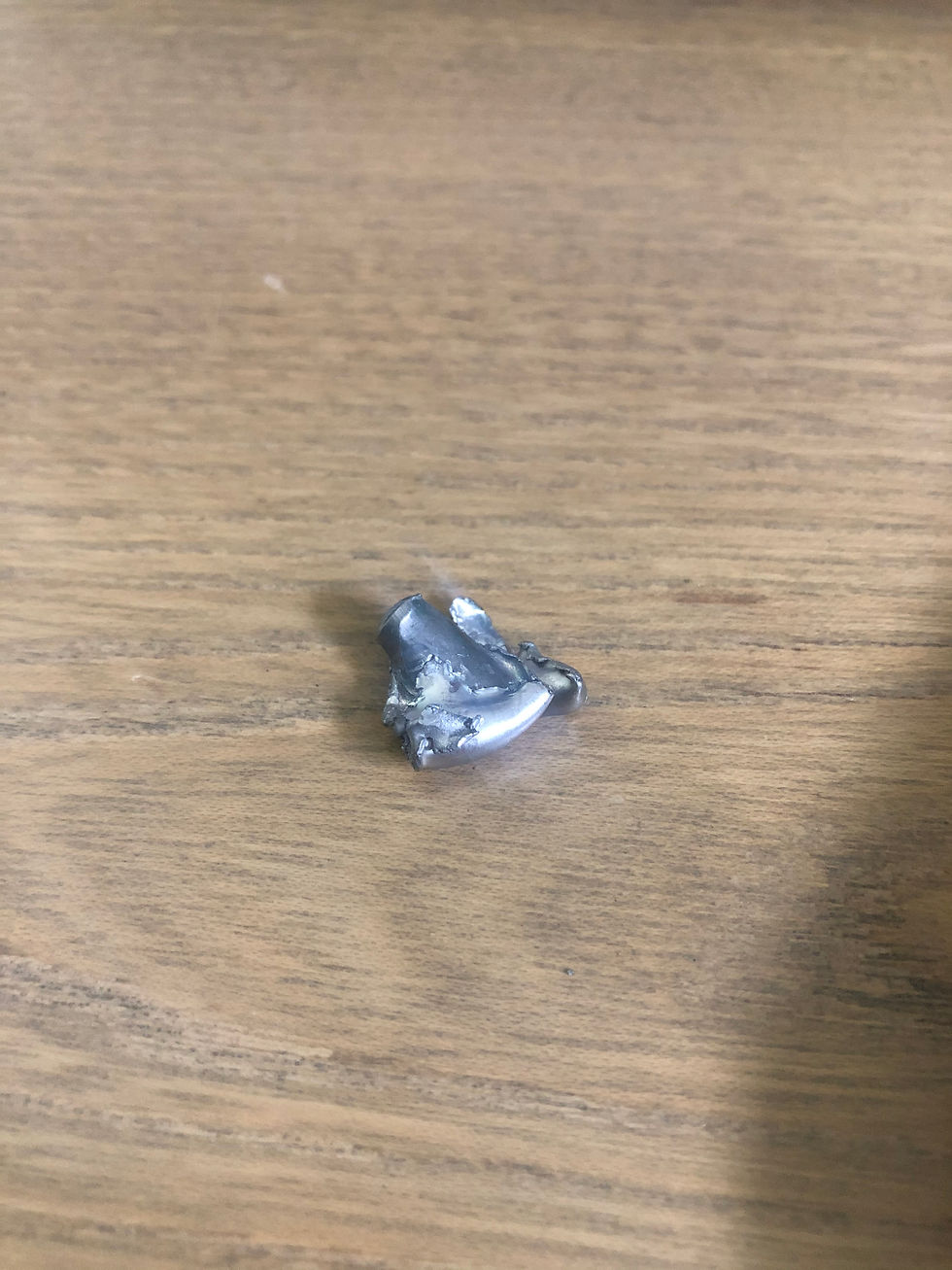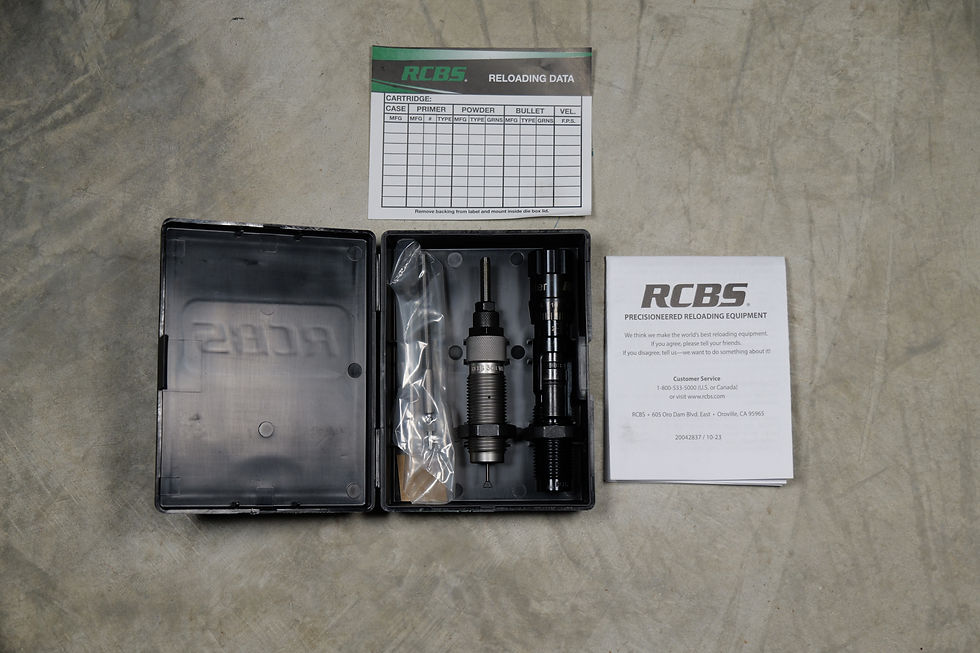140 Grain Match Burner Gel Block Test
- Reloading_allday

- Apr 29, 2020
- 7 min read
Updated: Jan 14, 2024
Hey guys! Welcome to the 140 Grain Match Burner Gel Block Test.
I wanted to test the Match Burner because I have heard about a few people using them for hunting applications. As a result, I wanted to see how this bullet would perform on ballistics gel to see what would happen. Given this is advertised against hunting applications, and solely for match scenarios, let's dive in and look at the results.
Barnes 140 Grain Match Burner in 6.5 Creedmoor.

The first thing I wanted to see, especially when talking about how well a bullet will perform, is to compare the bullets data to what is advertised.
Out of a box of 500 bullets, I selected at random 100 to be tested. Here are the results:

Diameter
Not too bad! As one can see, I experienced different diameters, lengths, and weight. With a published .264" diameter, I was seeing 0.26385" consistently across the board. In this case, off by 0.00015".
Length
Length is advertised at 1.341" and I found 1.354" in my sample. This leaves us with a 0.013" difference.
Weight
With an advertised weight at 140 grains, I had found with my sample the average to be 140.25 Gr. Off by 0.25 grains.
Load Workup for the Barnes Bullets 140 Matchburner
I had been hearing a lot about the Long Rifle powder from Shooters World being pretty good, so, I decided to give it a try. With the numerous options out there for 6.5 creed, this worked out really well in relation to yielding low SD and ES. Along with this powder, there is virtually no muzzle flash. The powder is a short cut extruded powder, which works well in volumetric powder throwers because of the kernel characteristics.
Here's a photo of my initial load workup.

Above is a chart showing the relationship between charge weight increase and velocity. After comparing all of the collected data, I opted for 41.7 grains of Long Rifle which put me in the range of 2810 FPS with an SD of 2 and an ES of 5.
Please keep in mind, the suggested maximum powder charge weight, according to Shooters World, is 40 grains with a 140 grain Sierra MK going 2657 FPS. If you do copy my load data, please workup in very small increments and be aware of any pressure signs that might show with your reloads.
Use load data at your own risk. Reloadingallday is not responsible for errors with load data on this website.

On another note, I was able to get up to around 2910 FPS before I started to get some hard bolt lift and pressure signs. However, given that the temperature was 60 degrees when the test was conducted, and this is a temperature stable powder, it can still fluctuate in speed just a bit as the weather warms up. Ultimately, this is why I opted for a slower, but, fast FPS for my testing.
So, what all components were you using, barrel length, build, etc?
Here's my hand-loading equipment and components listed below for those who are interested. If not, just skip on down to the rest of the article.
1. Forster Coax
Brass was prepped as explained here, seated at suggested C.O.A.L of 2.700", Starline 6.5 LRP cases, and regular Winchester LRP.
Rifle
On Paper

4 round group to the right: 0.385"-0.26385"=0.12115" group!
5 round group (including my pull of the shot...I was pretty angry seeing this as the next four shots started piling up, ha!): 0.832"-0.26385"= 0.56815"
Ballistics test
After finalizing the load at 2810 FPS, I wanted to try some other speeds in the gel block to show what it would take to produce certain amounts of expansion, variances in the neck, max penetration, and more. Note that these tests were done on bare gelatin. Clear Ballistics to be specific. Testing with bones will be soon to follow in another article.
First test 41.7 grains, 2810 FPS MV @100 yards. Temp: 60 F, Humidity: 32%, Pressure: 29.03

The maximum penetration depth as you can see is 16.75" here. However, the projectile completely fragmented.

At a closer look, the jacket is at the max-penetration point of 16.75" while the remaining of the bullet is left in between the 14"-16" mark.

Here is a top view of the block to give you another perspective on what happened with the projectile.

The neck is set at around 3-4" before any major changes can be seen.
Results below:


Second Test 140 Grain Match Burner 40.9 2738 FPS MV @100 yards. Temp: 62 F, Humidity: 30%, Pressure: 28.99.




Interestingly enough, right at max penetration, I found the jacket separated perfectly touching the lead in the photo above. The lead itself weighs: 47.80 gr and the jacket weighs: 37.10 gr
39.8 grains (2651 FPS MV), 39.4 grains (2566 FPS MV), and 37.8 grains (2536 FPS MV) gel block testing.


It is important to note that complete jacket separation occurred at only 8 1/2" in from
the beginning of the block. Temp: 63 F, Humidity: 30%, Pressure: 28.96

As you can see, as the MV is decreased, more of the projectile stays intact and yields a heavier retained weight at max penetration. Temp: 62 F, Humidity: 31%, Pressure: 28.93



Finally, we have our last test which had the best-retained weight and max penetration.Temp: 61 F, Humidity: 31%, Pressure: 28.90
Let's break some of this Gel data down.
2810 MV

First, we must know that the difference between MV and what the speed is at the gel blocks. My muzzle velocity was recorded with a Magneto Speed Sporter. Please keep in mind from the gel tests above, I have labeled them with the MV, and have provided you with the chart above to get a rough idea of how fast things were going at an MV of 2810. As in, at 100 yards with an MV of 2810, the velocity was around 2652 FPS as it entered into the block.
Since our last test was the most successful with retained weight, not much jacket separation, and short length of neck, let's see the MV at different yardages below.
2536 MV

So, is this a bullet that can be used for both match and hunting applications? I'll let you be the judge based on my data. However, it really depends on what type of hunting we are talking about here. If you are not concerned about conserving meat, I don't think many would care about complete fragmentation and would prefer this projectile, being more accurate, over a hunting style of bullet with a lower BC. If you want to run things slower with this projectile, as you can see, you will get some pretty decent penetration at lower velocities.
You can also view this through the spectrum that you might be the type of person who is hunting things at a longer range than normal, let's say a couple hundred yards. For instance, if you use the data from my initial load of 2810 FPS, right at 300 yards based off the data presented, you will be going 2351 FPS and will see the same expansion as the last gel block test with what was produced at 100 yards since that was going around 2387 FPS.
Another helpful aspect is to show a direct comparison to a similar projectile to show other results. Rest assured, I will be testing 30-40 other projectiles in different cartridges coming up, and we will be really diving in then.
It's something to consider when thinking about this: Is this only a match bullet or can this really be used for hunting applications too? You be the judge. please leave your comments below.
As always, shoot straight, be safe, and happy reloading! If you liked this article and think it was worth $1, please consider donating: https://www.patreon.com/Reloadingallday

Blake has been writing reloading articles for three years and helping out within the community to further enhance reloading education. In his free time, he works within the community to help out new hand-loaders by educating them on the many variables that come with this wonderful hobby. His passion is solely based on helping others so that they may pass on that information to future generations, keeping the art of hand-loading alive.
Disclaimer: The content you are about to read is for demonstration purposes only. This includes videos, blog posts, articles, and all information associated with this website. Do not attempt anything you see on this website. Again, these are for demonstration purposes only. If you see reloading data and or comments, please refer to the manufacturer of your choice and contact a technician. We are not responsible for any false data or comments from individuals. Again, this is a demonstration for reloading. Please contact or take classes from certified reloading instructors or contact the manufacturer of your choice. Please, do not attempt to tamper or modify with ammunition or firearms. Seek out a licensed professional or gunsmith. Any information you watch or read on this website must be assumed to have an error and should not be performed. Reloadingallday will not and cannot be held responsible for harm caused to readers and watchers. The material that is covered is for demonstration purposes only. Please be aware that hand-loading and other topics covered are very dangerous and you are within full responsibility and liability for your actions. Reloadingallday is also not responsible or liable for any damage that might be caused due to those who enter this website and read any of our material or watch. Again, this is for demonstration purposes only. By reading this article, you are agreeing that you are responsible for yourself, everyone around you, watchers, viewers, commenters, and fans. You are also agreeing that you are responsible for the safety and property as follows: yourself, everyone around you, watchers, viewers, commentators, and fans. Also, you are accepting that you agree with everything this disclaimer has written down.
Keep in mind that we may receive commissions when you click our links and make purchases. However, this does not impact our reviews and comparisons. We try our best to keep things fair and balanced, in order to help you make the best choice for you.




Comments